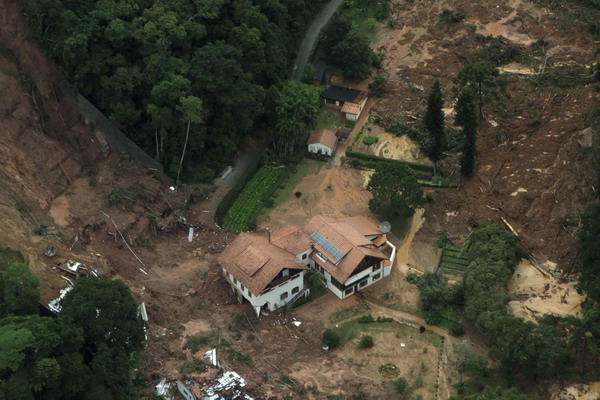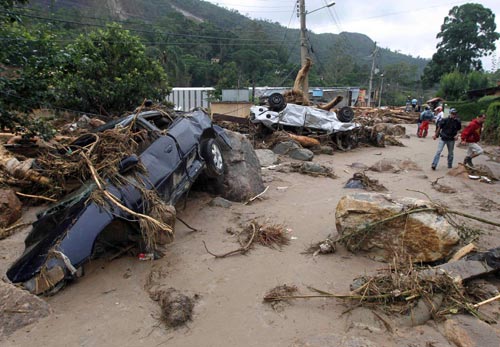Photos
Brazil flood deaths rise to 400; rescuers struggle
Updated: 2011-01-14 07:20
(Agencies)
|
 An aerial view of a neighborhood partially destroyed by a landslide caused by heavy rains in Nova Friburgo, Jan 13, 2011. [Photo/Agencies]
|
TERESOPOLIS, Brazil - Rescue workers dug desperately for survivors on Thursday and struggled to reach areas cut off by raging floods and landslides that have killed at least 400 people in one of Brazil's deadliest natural disasters in decades.
|
||||
"It's like an earthquake struck some areas," said Jorge Mario, the mayor of the Teresopolis, where at least 175 people were killed in the flooding.
"There are three or four neighborhoods that were totally destroyed in rural areas. There are hardly any houses standing there and all the roads and bridges are destroyed."
The mudslides swept away the homes of rich and poor alike in and around Teresopolis and other towns, likely causing billions of dollars in damage. But the brunt of the disaster was borne by poorer rural residents in houses built in risky areas without formal planning permission.
The floods have not affected Brazil's main export crops -- soy, sugar cane, oranges and coffee -- although they could further push up local food prices as the small Serrana region is an important producer of fruit and vegetables for the Rio metropolitan area,
Television images showed rescuers trying to haul residents from raging flood waters, and going through the ruins of homes in search of survivors, often finding only corpses. One success came when a six-month-old baby was rescued alive from the rubble of a house, drawing thunderous cheers from residents.
One woman held a dog in the ruins of her house as powerful waters tore at the remaining walls. She grabbed a rope thrown by residents from a nearby rooftop and was eventually pulled to safety, after dropping the dog into the vicious current.
In Nova Friburgo, a rural town first settled by Swiss immigrants, at least 168 people died, local officials said.
President Dilma Rousseff, facing the first major challenge of her presidency after taking office on January 1, called it a tragedy that couldn't be blamed only on mother nature.
"Housing in areas of risk is the rule in Brazil rather than the exception," she said in Rio after flying over the flooded region and visiting Nova Friburgo, where much of the damage was done to homes built precariously at the base of steep hills.
"When there aren't housing policies, where are people who earn no more than twice the minimum wage going to live?"
Landslides and flash floods are common in much of Brazil, often exposing poor urban planning and a lack of preventive action by authorities.
Lines of Bodies
 |
|
Residents walk past destroyed cars after a landslide in Teresopolis January 13, 2011. [Photo/Agencies] |
Hillsides and riverbanks in the area about 60 miles (100 km) north of Rio, which will co-host the 2014 World Cup and host the 2016 Olympics, collapsed after the equivalent of a month's rain fell in 24 hours from Tuesday night.
Folha de Sao Paulo newspaper said it was the worst natural disaster to hit Brazil in four decades. More heavy rain is forecast for the coming days, complicating rescue efforts and raising the risk of further mudslides.
Raging flood waters and rivers of mud totally submerged some houses and left cars crumpled like tin cans. More then 13,500 people were also left homeless, authorities said.
Rescue teams had yet to reach several of the worst-hit parts of Teresopolis, including one neighborhood where around 150 houses were believed to have been destroyed.
Dozens of bodies were lined up outside a police station in the city center awaiting identification before being moved to a church, local taxi driver Vinicius Bittencourt told Reuters.
"The bodies were there because there is no more space in the morgue," he said. "People are walking in the street crying. I've seen people carrying dead children wrapped in blankets."
At least 39 people also died in Petropolis, a picturesque town nestled in the mountains that served as the summer residence for Brazil's royal family in the 19th century.
Firefighters used heavy machinery to remove debris blocking their path to some of the worst-affected areas.
"The situation is critical, but we have to advance, we can't stop," said fire department colonel Jose Paulo Miranda.
Rousseff has earmarked 780 million reais ($460 million) in emergency aid for the region. The government said it was also sending 210 troops from the National Public Security Force, including officials to help identify bodies.
Two Navy helicopters are assisting rescue operations and the Navy is also sending a mobile field hospital to the area.
|
 An aerial view of a neighborhood partially destroyed by a landslide caused by heavy rains in Nova Friburgo, Jan 13, 2011. [Photo/Agencies]
|
E-paper

Ear We Go
China and the world set to embrace the merciful, peaceful year of rabbit
Preview of the coming issue
Carrefour finds the going tough in China
Maid to Order
Specials

Mysteries written in blood
Historical records and Caucasian features of locals suggest link with Roman Empire.

Winning Charm
Coastal Yantai banks on little things that matter to grow

New rules to hit property market
The State Council launched a new round of measures to rein in property prices.



